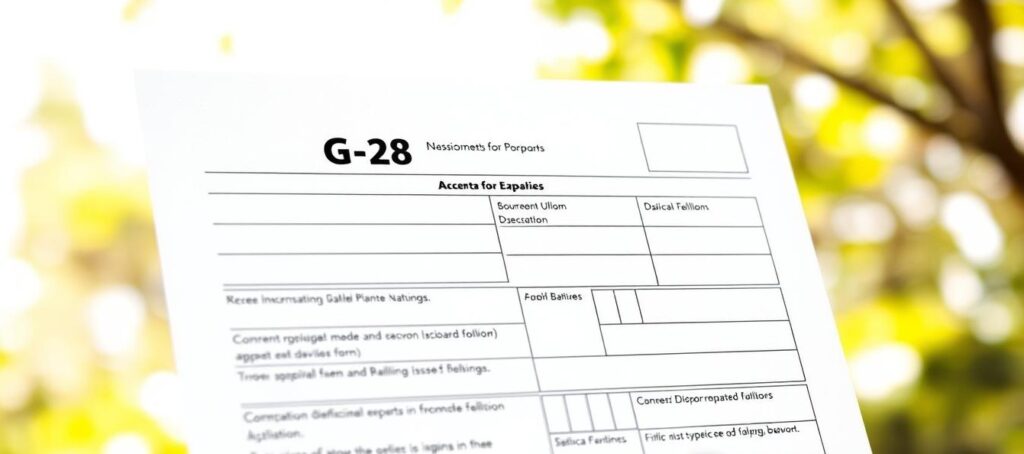G-28 Form: What It Is and How to File It
Dealing with immigration or legal issues in the United States can be tough. There are many forms and documents that you need to be aware of. The G28 form is one of them.

We’ll help you understand what the G-28 representation form is and why it matters. This article provides a detailed guide. It will help you file it right.
By the end of this article, you’ll know all about the G-28 representation form. You’ll be ready to handle its needs.
Key Takeaways
- Understanding the purpose of the G-28 representation form.
- Learning how to file the G-28 form correctly.
- Identifying the required information and documents.
- Recognizing the significance of the G-28 form in legal proceedings.
- Navigating common challenges associated with the G-28 form.
Understanding the G-28 Form
To get what the G-28 form is about, we need to know its purpose. It’s a document for immigration cases. It tells the U.S. Citizenship and Immigration Services (USCIS) who is representing a client.
Definition and Official Name
The G-28 form is called the “Notice of Entry of Appearance as Attorney or Representative.” It allows attorneys and accredited representatives to state that they’re working for a client in immigration cases. It’s key to showing who is representing someone in immigration matters. The form asks for the representative’s and client’s details, ensuring USCIS knows who’s who.
Purpose in Immigration Proceedings
The primary purpose of the G-28 form is to inform USCIS of who’s representing someone. This allows the representative to receive messages and make appearances on behalf of the client. By using the G-28 form, representatives can assist their clients throughout the entire immigration process.

Who Needs to File the G-28 Form
The G-28 form is essential for individuals who assist clients in immigration cases. It’s necessary to know who needs to file this form to comply with immigration rules.
Attorneys Representing Clients
Lawyers who help clients in immigration cases must file the G-28 form. This form indicates that they are authorized to act on behalf of their clients. It enables lawyers to obtain essential information from USCIS for their clients.
Accredited Representatives
Not just lawyers, but also accredited representatives can file the G-28 form. These representatives work for groups approved by the Board of Immigration Appeals. The G-28 form enables them to represent clients and receive official updates on their cases.
The 2025 Version of the G-28 Form
The 2025 G-28 form has new rules that lawyers and accredited reps need to know. These changes help meet USCIS standards.
Updates and Changes from Previous Versions
The 2025 G-28 form features updates designed to simplify filing and reduce errors. Now, client info is more detailed.
It also includes new parts that explain what the lawyer will do and the type of immigration case.
| Change | Description | Impact |
|---|---|---|
| Revised Client Information | More detailed client data required | Improved accuracy in filings |
| Updated Scope of Representation | More precise definitions of the representation scope | Reduced misunderstandings in proceedings |
| New Sections for Immigration Proceedings | More specific categorization of proceedings | Enhanced organization and processing of cases |
Validity Period and Expiration
The G-28 form remains valid until the immigration case is resolved or the lawyer-client relationship is terminated.
However, USCIS may request a new G-28 form if the lawyer’s role changes or the client’s information updates.
It’s a good idea to regularly check the form’s validity, especially in long or complex cases.
What Is the G-28 Form Used For
The G28 form plays a crucial role in immigration cases. Lawyers and representatives must understand its significance. This knowledge enables them to serve their clients more effectively.
Establishing an Attorney-Client Relationship
The G28 form marks the start of the attorney-client bond. When filed, it tells USCIS the lawyer is now part of the case. This move empowers the lawyer to represent the client in immigration matters.
Authorizing Communication with USCIS
Another primary use of the G-28 form is to inform USCIS of whom to contact. After filing, USCIS sends all case updates to the lawyer. This keeps the lawyer informed about the case’s status and any USCIS requests.
Scope of Representation
The G-28 form also outlines the services that the lawyer can provide to the client. It clearly states the lawyer’s role. This avoids confusion and makes sure the lawyer only does what they’re allowed to do.
| Purpose | Description |
|---|---|
| Establishing an Attorney-Client Relationship | Formally notifies USCIS of the representative’s involvement in the case. |
| Authorizing Communication with USCIS | Directs USCIS to correspond with the representative regarding the client’s case. |
| Scope of Representation | Specifies the matters for which the representative is authorized to act. |
Required Information for Completing the G-28 Form
Knowing what info is needed for the G28 form is key to a smooth filing. The G28 form establishes the lawyer-client relationship in immigration cases. It must be filled out correctly.
Attorney or Representative Information
The form requests the details of the lawyer or accredited representative. You need their name, address, and contact information. Ensure this information is accurate and up-to-date to avoid any issues.
The form also requests the lawyer’s USCIS Online Account Number, if available. And their signature is a must. This shows they agree to handle the client’s case.
Client Information
The client’s info is also crucial. You’ll need their full name, address, and other key details. The form also asks about their immigration case, like the receipt number.
It’s essential to obtain the client’s information accurately. Any mistakes could slow down the processing of the form.
Eligibility Information
The form also needs to indicate whether the lawyer or representative is authorized to represent the client. This means details about their law license or accreditation.
Correct eligibility info is vital. It helps USCIS determine that the representative is authorized to act on the client’s behalf.
| Information Category | Required Details |
|---|---|
| Attorney/Representative | Name, Address, Contact Information, USCIS Online Account Number (if applicable) |
| Client | Full Name, Address, Receipt Number or Alien Registration Number |
| Eligibility | Admission to Practice Law or Accreditation Status |
Step-by-Step Guide to Filling Out the G-28 Form
Knowing how to complete the G28 form is crucial for effective representation in immigration cases. The form has four main parts. Each part needs specific info for an accurate and valid representation.
Part 1: Information About Attorney or Accredited Representative
The first part requests the details of the attorney or accredited representative. You need to provide their name, address, and contact info. Ensure this information is accurate and up-to-date for seamless USCIS communication.
Part 2: Information About the Client
This section is for the client’s details. You’ll need their full name, date of birth, and address. It’s essential to get this right as it’s tied to their identity and case.
Part 3: Notice of Appearance as Attorney or Representative
This part is the official notice of appearance. You must specify the immigration court or USCIS office involved. Correctly identifying the authorities is crucial for proper processing.
Part 4: Client’s Consent to Representation and Signature
The last part requires the client’s consent and signature. This step is vital for establishing the attorney-client relationship and authorizing representation.
To fill out the G-28 form, follow these steps:
- Give accurate info about the attorney or accredited representative
- Provide the client’s personal and case details
- Notify the relevant immigration authorities
- Get the client’s consent and signature
By following these steps and ensuring all information is correct, attorneys and accredited representatives can file the G-28 form effectively. This establishes a formal relationship and facilitates communication between USCIS, thereby making the immigration process smoother.
How to Submit the G-28 Form
The way you submit the G-28 form depends on your case status. It’s essential to know the proper steps, whether it’s for a new application or an ongoing case.
Filing with Initial Application or Petition
When filing the G-28 form with a new application, ensure all details are accurate. This includes your attorney’s and client’s information. Doing this right helps keep USCIS informed. You should submit the G-28 form with your application to demonstrate that you’re working together.
Filing for an Existing Case
For an existing case, please provide the case details and the receipt number. This helps USCIS link the form to your case. Also, update your client’s file with the new information. Filing for an ongoing case needs careful attention to avoid issues.
Electronic Submission Options
USCIS lets you file the G-28 form online. Online filing makes things faster and easier. To do this, create an account on the USCIS website. Then, follow the steps to upload your G-28 form. This way, you save paper and time.
Common Mistakes to Avoid When Filing the G-28 Form
The G-28 form is key in immigration cases. It must be completed correctly to avoid issues. Attorneys and representatives should be aware of common mistakes to avoid, making the process easier.
Incomplete Information
One big mistake is leaving out important details on the G28 form. This includes missing information about the client or the representative. It’s essential to review the form carefully before sending it. Ensure that all required fields are completed correctly.
Missing Signatures
Failing to obtain the necessary signatures is another significant error. The G-28 form needs signatures from both the client and the representative. Without signatures, the form might be delayed or rejected. Always verify that all signatures are present before filing.
Incorrect Form Version
Using an old or wrong version of the G-28 form is common. The USCIS frequently updates its forms, and using an outdated one can result in delays. Always check the USCIS website for the latest version of the G-28 form and use the correct one.
| Common Mistake | Consequence | Prevention |
|---|---|---|
| Incomplete Information | Delays or Rejection | Thorough Review |
| Missing Signatures | Delays or Rejection | Verify Signatures |
| Incorrect Form Version | Processing Delays | Check USCIS Website |
Knowing these common mistakes and how to avoid them helps attorneys and representatives. This makes the immigration process smoother for their clients.
Legal Implications of the G-28 Form
It’s essential to understand the legal aspects of the G-28 form for practical legal assistance. The G-28 form is more than a simple document. It has significant legal implications that can alter the lawyer-client relationship and the progression of immigration cases.
Scope of Representation Limitations
The G-28 form outlines the scope of representation, which is crucial in the lawyer-client relationship. By filing the G-28 form, lawyers or accredited representatives indicate the extent of their assistance with the client’s immigration case. This scope is not endless; it’s limited to what’s listed on the form.
It’s critical to write down the scope of representation carefully. This ensures that it covers all aspects of the client’s case.
Not having a clear scope can cause problems. For example, if the scope is too narrow, essential issues might be missed. This could harm the client’s case.
Withdrawal of Representation
Another significant legal point about the G-28 form is how to withdraw from a case. Lawyers or representatives may need to step away for reasons such as a poor working relationship or ethical concerns. The G-28 form outlines the process for notifying USCIS, which is essential for complying with the rules.
Stepping away from a case means more than just telling the client. You must also inform the USCIS and, in some cases, the immigration court. This ensures that everyone is aware of the change, preventing confusion or issues in the case.
Where to Find Help with the G-28 Form
Finding help with the G-28 form can be tough. However, there are resources available to help. Understanding and filing this form is key in immigration cases. The proper support can help.
USCIS Resources and Support
The United States Citizenship and Immigration Services (USCIS) has many resources for the G-28 form. Their official website has detailed instructions. It covers everything from filling out the form to submitting it.
USCIS also offers customer support through its contact center. Here, you can get answers to your questions about the form and the filing process.
Professional Assistance Options
If you need further assistance, professional options are available. Attorneys who specialize in immigration law can guide you. They can assist with completing and submitting the G-28 form.
Accredited representatives recognized by the USCIS can also help. These professionals ensure the form is completed correctly. They help avoid delays or problems in your immigration case.
Conclusion
Being familiar with the G-28 form is crucial for lawyers and accredited representatives in U.S. immigration cases. This form is essential for establishing the lawyer-client relationship. It also allows them to communicate with U.S. Citizenship and Immigration Services (USCIS).
The G-28 form helps in many ways. It lets lawyers represent clients in immigration cases. It also allows them to get info from USCIS. By using this form, lawyers ensure they receive updates on their clients’ cases.
To file the G-28 form correctly, you must fill out all parts correctly. Then, please send it to USCIS. Always use the latest version, like the G-28 form 2025, to avoid problems.
In short, the G-28 form is significant. It helps lawyers, clients, and USCIS communicate more effectively. By knowing how to use it, lawyers can help their clients more effectively.
FAQ
What is the G-28 form used for?
The G28 form is used to show who represents you in immigration cases. It informs USCIS of who to contact and what you can do together.
Who needs to file the G28 form?
Lawyers and certain representatives are required to file the G28 form. This tells USCIS who is representing you.
What information is required to complete the G-28 form?
You need to give details about the lawyer or representative, the client, and the client’s eligibility. This information is crucial for the form.
How do I submit the G28 form?
You can file the G28 form with an initial application or for an ongoing case. You can also use electronic options.
What are the common mistakes to avoid when filing the G-28 form?
Don’t leave out essential details, forget to sign, or use the wrong form version. These mistakes can cause delays.
What is the validity period of the G-28 form?
The validity and expiration dates of the G28 form are subject to change. Always check the instructions or ask USCIS for the latest info.
Can I file the G-28 form electronically?
Yes, you can file the G28 form online. USCIS offers electronic submission options.
What are the legal implications of filing the G-28 form?
Filing the G28 form establishes the boundaries of your representation and allows USCIS to communicate with you. It’s important to understand these legal aspects before filing.
Need Help Filing Your Forms? Contact Syed Professional Services Today!
If you’re feeling overwhelmed with paperwork or unsure about how to properly file forms like the G-28, W-7, or I-693, don’t worry — you’re not alone. At Syed Professional Services, we specialize in helping individuals and businesses navigate complex government forms with ease and accuracy. Our experienced team is committed to providing personalized support, ensuring that every document is prepared and submitted correctly and on time.
Whether you need assistance with immigration forms, tax filings, or general document preparation, we’re here to help every step of the way. We take pride in delivering reliable, fast, and affordable services that take the stress out of the process.





